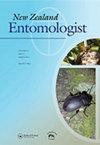实验性高密度诱捕群居黄蜂:工蜂的目标激素还是雄蜂的目标激素?
IF 0.4
4区 农林科学
Q4 ENTOMOLOGY
引用次数: 1
摘要
摘要群居黄蜂是新西兰最令人厌恶的外来捕食者之一,对当地生态系统和动物群产生了广泛的不利影响。山毛榉林迫切需要可持续的杀虫剂替代品。我们测试了一种新的信息化学评估方案,以评估高密度诱捕器竞争的程度,作为大规模诱捕的指标,在卡斯(新西兰坎特伯雷)附近的山毛榉林附近的开阔景观中,潜在的工人或无人机被移走。我们使用1公顷规模的前后对照冲击设计,用25个桶形诱捕器网格作为高密度诱捕处理(三个重复),测试了kairomone诱饵。试验受到了一次重大洪水事件的影响,在接下来的一个月里,两种处理的渔获量都稳步下降,处理效果没有显著差异。在粘性诱捕器中捕获的无人机对1、3或10只雌性(处女女王)的捕获显示出剂量反应。粘性陷阱诱饵与三个女性在一个5 × 5阵列超过1 ha(四个重复),在高密度和对照陷阱中,每个陷阱平均每天捕获7.39(±0.88)只无人机(n = 116),但在控制和处理地块中,每个中心陷阱捕获的无人机数量没有差异(n = 每个小区4个),证明了在这种流动物种的极端种群压力下我们的方法的局限性。建议鉴定和研究雌虫性信息素在全区域抑制中的潜在用途,因为它作为引诱剂比测试的信息素更有前景。http://www.zoobank.org/urn:lsid:zoobank.org:act:C0809A1F-87C2-431C-BA14-548F00D954F9本文章由计算机程序翻译,如有差异,请以英文原文为准。
Experimental high-density trapping of social wasps: target kairomones for workers or gynes for drones?
ABSTRACT Social wasps are amongst the most loathed exotic predators in New Zealand, with widespread adverse impacts on native ecosystems and fauna. Sustainable alternatives to pesticides are sorely needed in Fuscospora (beech) forests. We tested a new semiochemical evaluation protocol to assess the extent of high-density trap competition as an indicator of mass trapping, in an open landscape adjacent to a beech forest near Cass (Canterbury, New Zealand), for potential worker or drone removal. We tested the kairomone lure using a before-after control-impact design at a 1-ha scale with a grid of 25 bucket traps as a high-density trapping treatment (three replicates). The trial was affected by a major inundation event and catches declined steadily in both treatments for the month following, and treatment effects were not significantly different. Drone captures in sticky traps showed a dose response in catch to 1, 3 or 10 gynes (virgin queens). Sticky traps baited with three gynes in a 5 × 5 array over 1 ha (four replicates), caught a mean of 7.39 (±0.88) drones per trap per day across the high density and control traps (n = 116), but there was no difference in the number of drones caught per central trap in the control and treatment plots (n = 4 per plot), demonstrating the limitations of our methods under extreme population pressure in such a mobile species. It is proposed that the gyne sex pheromone be identified and investigated for potential use in area-wide suppression, as it holds more promise as an attractant than the kairomones tested.http://www.zoobank.org/urn:lsid:zoobank.org:act:C0809A1F-87C2-431C-BA14-548F00D954F9
求助全文
通过发布文献求助,成功后即可免费获取论文全文。
去求助
来源期刊

New Zealand Entomologist
ENTOMOLOGY-
CiteScore
0.70
自引率
33.30%
发文量
3
审稿时长
>12 weeks
期刊介绍:
The invertebrate diversity of New Zealand is of great interest worldwide because of its geographic isolation and geological history. The New Zealand Entomologist plays an important role in disseminating information on field-based, experimental, and theoretical research.
The New Zealand Entomologist publishes original research papers, review papers and short communications. We welcome submissions in all aspects of science regarding insects and arthropods in a New Zealand or Australasian setting. The journal’s subject matter encompasses taxonomy, phylogenetics, biogeography, biological control and pest management, conservation, ecology and natural history.
The journal is the official publication of the Entomological Society of New Zealand. Papers published or submitted elsewhere for publication will not be considered, but publication of an abstract or summary elsewhere (e.g. conference proceedings) does not preclude full publication in the New Zealand Entomologist. Accepted papers become copyright of the Entomological Society of New Zealand. The journal is published in English, but we also welcome publication of abstracts in Maori.
 求助内容:
求助内容: 应助结果提醒方式:
应助结果提醒方式:


